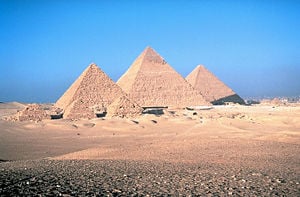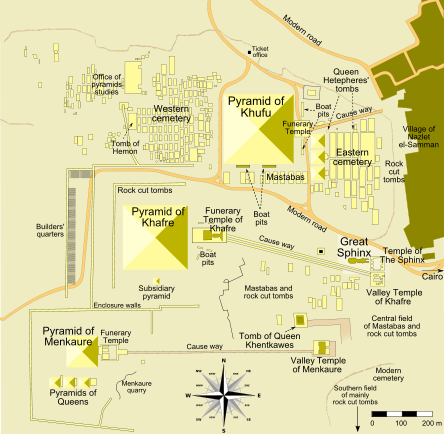Pyramids of Giza
| Memphis and its Necropolis - the Pyramid Fields from Giza to Dahshur* | |
|---|---|
| UNESCO World Heritage Site | |

| |
| State Party | |
| Type | Cultural |
| Criteria | i, iii, vi |
| Reference | 86 |
| Region** | Arab States |
| Inscription history | |
| Inscription | 1979 (3rd Session) |
| * Name as inscribed on World Heritage List. ** Region as classified by UNESCO. | |
The Giza Necropolis stands on the Giza Plateau, on the outskirts of Cairo, Egypt. This complex of ancient monuments is located some eight kilometres (5 mi) inland into the desert from the old town of Giza on the Nile, some 25 kilometres (12.5 mi) southwest of Cairo city centre.
Description
This Ancient Egyptian necropolis consists of the Pyramid of Khufu (known as the Great Pyramid and the Pyramid of Cheops; coordinates {{#invoke:Coordinates|coord}}{{#coordinates:29|58|31.3|N|31|07|52.7|E|type:landmark | |name= }}), the somewhat smaller Pyramid of Khafre (or Chephren; coordinates {{#invoke:Coordinates|coord}}{{#coordinates:29|58|33.72|N|31|07|51.6|E|type:landmark | |name= }}), and the relatively modest-size Pyramid of Menkaure (or Mykerinus; coordinates {{#invoke:Coordinates|coord}}{{#coordinates:29|58|19.8|N|31|07|43.4|E|type:landmark | |name= }}), along with a number of smaller satellite edifices, known as "queens" pyramids, causeways and valley pyramids, and most noticeably the Great Sphinx. Current consensus among Egyptologists is that the head of the Great Sphinx is that of Khafre. Associated with these royal monuments are the tombs of high officials and much later burials and monuments (from the New Kingdom onwards), signifying the reverence to those buried in the necropolis.
Of the three, only Menkaure's Pyramid is seen today sans any of its original polished limestone casing, with Khafre's Pyramid retaining a prominent display of casing stones at its apex, while Khufu's Pyramid maintains a more limited collection at it's base. It is interesting to note that this pyramid appears larger than the adjacent Khufu Pyramid by virtue of its more elevated location, and the steeper angle of inclination of its construction – it is, in fact, smaller in both height and volume. The most active phase of construction here was in the 25th century B.C.E.. The ancient remains of the Giza necropolis have attracted visitors and tourists since classical antiquity, when these Old Kingdom monuments were already over 2,000 years old. It was popularised in Hellenistic times when the Great Pyramid was listed by Antipater of Sidon as one of the Seven Wonders of the World. Today it is the only one of the ancient Wonders still in existence.
Due largely to 19th-century images, the pyramids of Giza are generally thought of by foreigners as lying in a remote, desert location, even though they are located in what is now part of the most populated city in Africa [1]. Consequently, urban development reaches right up to the perimeter of the antiquities site, to the extent that in the 1990s, Pizza Hut and KFC restaurants opened across the road [2] [3]. The ancient sites in the Memphis area, including those at Giza, together with those at Saqqara, Dahshur, Abu Ruwaysh, and Abusir, were collectively declared a World Heritage Site in 1979 [4].
Major components of the complex
- Pyramid of Khufu
- Pyramid of Khafre
- Pyramid of Menkaure
- Great Sphinx
- Khufu ship
Alternative theories
Orion correlation
Although hypotheses put forward by Robert Bauval are by nature universally regarded by mainstream archaeologists [1] and Egyptologists as a form of pseudoscience, Robert Bauval and Adrian Gilbert (1994) proposed that the three main pyramids at Giza form a pattern on the ground that is virtually identical to that of the three belt stars of the Orion constellation. Using computer software, they wound back the Earth's skies to ancient times, and witnessed a 'locking-in' of the mirror image between the pyramids and the stars at the same time as Orion reached a turning point at the bottom of its precessional shift up and down the meridian. This conjunction, they claimed, was exact, and it occurred precisely at the date 10,450 B.C.E.. And they claim that Orion is "West" of the Milky Way, in proportion to Giza and the Nile.[2] Also, in 1993, Rudolph Gantenbrink, sent his robotic device titled 'Uphaut 2' which means 'opener of the ways' into the northern shaft of the Queen's Chamber in the Great Pyramid at Giza. There they discovered a secret chamber that hasn't been opened in about 4,500 years which is discussed in Bauval's and Gilbert's book "The Orion Mystery." Also discussed in this 1994 book are the tools that the Dixon brothers found when the Great Pyramid was opened in the 1870s. These tools that were found may verify that the Bronze Age and Iron Age in Egypt had actually begun centuries before anyone thought. In 2002, Egyptologist Zahi Hawass used a robot to go past that secret chamber. There he found another stone block, which is possibly a door. What's behind that door is unknown but it is likely extremely important: ancient papyrus that was written during the First Time when Osiris walked the actual earth of Egypt or a statue of Khufu, etc. This event was broadcasted live on the National Geographic Channel in April 2003 and discussed in an article titled "Ancient Egyptian Chambers Explored" written by Nancy Gupton for National Geographic News in April 2003.
Notes
ReferencesISBN links support NWE through referral fees
- Lehner, Dr. Mark, "The Complete Pyramids," Thames & Hudson, 1997. ISBN 0-500-05084-8.
- Manley, Bill (Ed.), "The Seventy Great Mysteries of Ancient Egypt," Thames & Hudson. ISBN 0-500-05123-2.
- "Mysteries of Egypt" National Geographic Society, 1999. ISBN 0-7922-9752-0.
- Rhys-Davies, John, "Riddles of the monument builders: Who built the Sphinx," Time-Life Video, 1995.
External links
- Wiki Satellite view of Giza Plateau at WikiMapia
- 3D model of the pyramids for use in Google Earth
- Pyramid Photographs on GlobalAmity.net
- Aerial view of Giza pyramids at Windows Live Local
- digital.egypt - QTVR fullscreen panoramas on Giza Plateau
- Pyramids in Giza Pictures of Giza Pyramids published under Creative Commons License
Credits
New World Encyclopedia writers and editors rewrote and completed the Wikipedia article in accordance with New World Encyclopedia standards. This article abides by terms of the Creative Commons CC-by-sa 3.0 License (CC-by-sa), which may be used and disseminated with proper attribution. Credit is due under the terms of this license that can reference both the New World Encyclopedia contributors and the selfless volunteer contributors of the Wikimedia Foundation. To cite this article click here for a list of acceptable citing formats.The history of earlier contributions by wikipedians is accessible to researchers here:
The history of this article since it was imported to New World Encyclopedia:
Note: Some restrictions may apply to use of individual images which are separately licensed.

